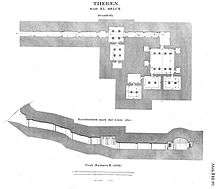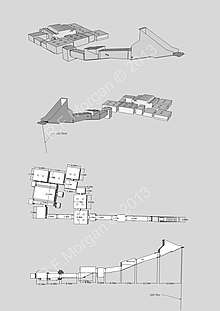KV7
Tomb KV7 in the Valley of the Kings was the final resting place of ancient Egyptian Pharaoh Ramesses II ("Ramesses the Great") of the Nineteenth Dynasty. It is located in the main valley, opposite the tomb of his sons, KV5, and near to the tomb of his son and successor, Merenptah, KV8. Unlike other tombs in the area, Tomb KV7 was placed in an unusual location and has been badly damaged by the flash floods that periodically sweep through the valley.
| KV7 | |||
|---|---|---|---|
| Burial site of Ramesses II | |||
_-_Egypt-4A-023.jpg) | |||
 KV7 | |||
| Coordinates | 25°44′26.3″N 32°36′5.61″E | ||
| Location | East Valley of the Kings | ||
| Discovered | Open in antiquity | ||
| Excavated by | Henry Salt Carl Lepsius Christian Leblanc (1991) | ||
| Decoration | Book of Gates Amduat Litany of Ra Book of the Dead Opening of the Mouth[1] | ||
Decoration and layout

KV7 follows the bent-axis plan of tombs of the earlier Eighteenth Dynasty. The burial chamber has a sunken central area and a vaulted ceiling. Much of the decoration has been damaged beyond repair – its section of the Valley is particularly susceptible to flash floods – but it would have been decorated with the standard Book of Gates, Amduat and Litany of Ra.
The mummy was relocated to the mummy cache in DB320, and the tomb was reused in the Third Intermediate and Roman periods for burials and by early tourists.

References
- Christian Leblanc. "The Tomb of Ramesses II and Remains of His Funerary Treasure". Archived from the original on 2006-09-19. Retrieved 2006-12-04.
- Reeves, N., & Wilkinson, R. H. The Complete Valley of the Kings. London: Thames and Hudson, 1996.
- Siliotti, A. Guide to the Valley of the Kings and to the Theban Necropolises and Temples. Cairo: A. A. Gaddis, 1996.
- Leblanc, Christian. "The Tomb of Ramesses II and Remains of his Funerary Treasure." Egyptian Archaeology; 10 (1997): 11-13.